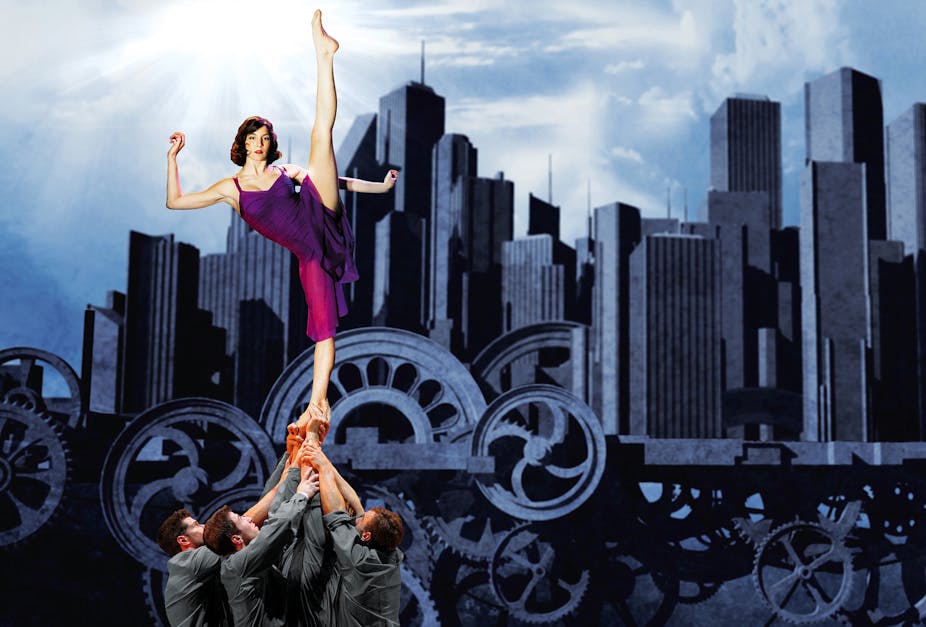Elegance, elite athleticism, light-handed humour and a gentle narrative about the value of individuality are the principal elements of Cirkopolis, which opens this week at the Melbourne International Arts Festival.
I saw this stylish and theatrically sophisticated show by Cirque Eloize, a Montreal-based ensemble of multi-disciplinary circus artists currently visiting Australia, at the Sydney Opera House this week.
The show’s narrative elements and visual décor reference Fritz Lang’s 1927 silent film, Metropolis. Like the film, Cirkopolis includes characters who search for intimacy within the environs of a futuristic urban dystopia. Charlie Chaplin’s 1936 film Modern Times, featuring the Little Tramp’s comic struggles to survive in an impersonal industrialised environment, is equally ghosted in this show.
The finely tuned ensemble of three female and nine male performers – from Canada, France, Netherlands, Germany, Spain and the UK – delivers this mesmerising mix of circus, dance and theatre with great finesse.
Circus is a hybrid art form that involves the display of physical skill, humour and theatrical artistry. Since its emergence in urban, industrialising societies of the late 18th century, it has been an adaptable performance genre, capable of absorbing aesthetic and cultural influences to suit the social and political context of its time.
Thanks to the innovations of pioneering “new” circus companies such as Circus Oz (Australia), Archaos (France), and Cirque du Soleil (Quebec), circus has been in a state of constant renewal since the 1970s. Recent incursions from the circus-invigorated Nordic countries — and inventive troupes such as Finland’s chaotic Race Horse Company — are now changing again how we understand circus.
The first Cirque Eloize was performed in 1997. The company is thus positioned mid-way along the historic timeline of the renewal of the circus arts that has been underway since the 1970s. In Australian terms, a circus company with an employee base of 100 would appear to be a substantial entertainment organisation.
In its home-town of Montreal, Cirque Eloize is a minnow when compared to its close neighbour, Cirque du Solieil, a global entertainment enterprise that employs 4,000 people worldwide, 1,300 of whom are performers.
These figures indicate Quebec’s unique contribution to the nurture and renewal of the circus arts over the past 40 years. They also point to Cirque Eloize’s capacity to develop its own style and establish a niche in the competitive milieu of high-end circus entertainment.

Directed by Jeannot Painchaud and Dave St-Pierre, Cirkopolis owes as much to the traditional circus form as it does to circus’s propensity to borrow, adapt and update. Forming the backbone of the show are elite demonstrations of physical skill on various apparatus.
These include the Chinese pole – a single vertical pole along which performers climb, slide, and pose. There’s also the teeterboard, which resembles a playground seesaw from which acrobats launch one another in order to perform aerial somersaults and land precisely on large mats, or into the hands of supporting performers.
We see the German wheel, a gymnastic device comprised of two large rings that can be manipulated by one or more acrobats. And then there’s the Cyr wheel, a single large metal hoop which the acrobat spins from inside the wheel while manoeuvring around the stage; and the gymnast’s aerial straps which require immense muscular control.
There’s contortion, trapeze, juggling, hand to hand acts of strength and balance, banquine – an acrobatic ensemble act that keeps the flier off the ground at all times – and a whimsical, romantic routine between the company’s “clown character”, played by Ashley Carr, and a feminine gown hanging on a clothes rack, to complete the featured acts of the show.

Following the processes of the traditional circus, finely choreographed entr’actes draw attention away from the construction and disassembling of apparatus equipment. This technical necessity can interrupt the flow of a circus-style show if not handled adroitly.
And of course Cirkopolis is as much dance and theatre as it is circus. The juggling act of the Dutch performer Joris de Jong elegantly fuses dance, acrobatics, and the unique handling skills of the juggler.
Myriam Deraiche’s contortion and aerial acrobatics embody the grace of the ballerina and the strength of the circus artiste, while Léa Toran Jenner’s elegant work on the Cyr wheel playfully captures the qualities of strength, grace, and artistry that should underpin all circus performance.
Abandoning any pretence of the traditional circus ring, computer-generated animation is the key technology Cirkopolis adopts for its renewed version of circus. Attractive animated video projections draw the audience into the show’s imaginative, industrialised landscape from the opening moments.
This provides the décor as well as the visual and narrative context within which the various characters of Cirkopolis struggle to establish their playful identities and make connections with others.
Cirque Eloize’s Cirkopolis is a delightfully uncluttered and enchanting moment in the evolution of the circus form.
Cirkopolis opens at the Melbourne International Arts Festival on October 10. Details here.

